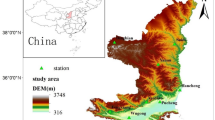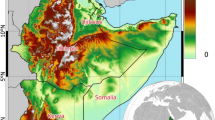Abstract
The effects of human activities on climate change are a significant area of research in the field of global environmental change. Land use and land cover change (LUCC) has a greater effect on climate than greenhouse gases, and the effect of farmland expansion on regional drought is particularly important. From the 1910s to the 2010s, cultivated land in Songnen Plain increased by 2.67 times, the area of cultivated land increased from 4.92×104 km2 to 13.14·104 km2, and its percentage of all land increased from 25% to 70%. This provides an opportunity to study the effects of the conversion of natural grassland to farmland on climate. In this study, the drought indices in Songnen Plain were evaluated from the 1910s to the 2010s, and the effect of farmland expansion on drought was investigated using statistical methods and the Weather Research and Forecasting Model based on UK’s Climatic Research Unit data. The resulting dryness index, Palmer drought severity index, and standardized precipitation index values indicated a significant drying trend in the study area from 1981 to 2010. This trend can be attributed to increases in maximum temperature and diurnal temperature range, which increased the degree of drought. Based on statistical analysis and simulation, the maximum temperature, diurnal temperature range, and sensible heat flux increased during the growing season in Songnen Plain over the past 100 years, while the minimum temperature and latent heat flux decreased. The findings indicate that farmland expansion caused a drying trend in Songnen Plain during the study period.
Similar content being viewed by others
References
Alexander L V, Zhang X, Peterson T C et al., 2006. Global observed changes in daily climate extremes of temperature and precipitation. Journal of Geophysical Research, 111(D5): 1–22. doi: 10.1029/2005 JD006290.
Betts R A, Fallon P D, Goldewijk K K et al., 2007. Biogeophysical effects of land use on climate: Model simulations of radiative forcing and large-scale temperature change. Agricultural and Forest Meteorology, 142(2–4): 216–233. doi: 10.1016/j.agrformet.2006.08.021.
Bonan G B, 2008. Forests and climate change: Forcings, feedbacks, and the climate benefits of forests. Science, 3205882): 1444–1449. doi: 10.1126/science.1155121.
Cao F Q, Dan L, Ma Z G et al., 2015. Simulative study of the cropland change on the regional climate over China. Acta Meteorologica Sinica, 731): 128–141. (in Chinese)
Chen D F, Sun Z Y, 2001. American agriculture production and the protection of resource and environment. Ecological Economy, 9: 60–65. (in Chinese)
Duhan D, Pandey A, Gahalaut K P S et al., 2013. Spatial and temporal variability in maximum, minimum and mean air temperatures at Madhya Pradesh in central India. Comptes Rendus Geoscience, 3451): 3–21. doi: 10.1016/j.crte.2012.10.016.
Dong S Y, Yan X D, Xiong Z, 2014. Modeled impacts of land-use and land-cover change in Northeast China on climate. Climatic and Environmental Research, 193): 351–361. doi: j.issn.1006-9585.2013.13022. (in Chinese)
Eastman J L, Coughenour M B, Pielke R A et al., 2001. Does grazing affect regional climate? Journal of Hydrometeorology, 23): 243–235.
Emerson P S, William E, Magnusson BS et al., 2018. Extinction risks forced by climatic change and intraspecific variation in the thermal physiology of a tropical lizard. Journal of Thermal Biology, 73: 50–60. doi: 10.1016/j.jtherbio.2018.01.013.
Feddema J J, Oleson K W, Bonan G B et al., 2005. The importance of land-cover changes in simulating future climate. Science, 3105754): 1674–1678. doi: 10.1126/science.1118160.
Findell K L, Shevliakova E, Milly PCDet al., 2007. Modeled impact of anthropogenic land cover change on climate. Journal of Climate, 2014): 3621–3634. doi: 10.1175/JCLI4185.1. (in Chinese)
Foley J A, DeFries R, Asner G P et al., 2005. Global consequences of land use. Science, 3095734): 570–574. doi: 10.1126/science.1111772.
Füssel H M, Klein R J T, 2006. Climate change vulnerability assessments: An evolution of conceptual thinking. Climatic Change, 753): 301–329. doi: 10.1007/s10584-006-0329-3.10.
Gao X J, Zhang D F, Chen Z X et al., 2007. Land use effects on climate in China as simulated by a regional climate model. Science in China: Earth Sciences, 504): 620–628. doi: 10.1007/s11430-007-2060-y. (in Chinese)
Ge Q S, Zheng J Y, Zhang X Z et al., 2013. Simulated effects of cropland expansion on summer climate in eastern China in the last three centuries. Advances in Meteorology, 652): 93–100. doi: 10.1155/2013/501014.
Hossein Tabari, Parisa Hosseinzadeh Talaee, 2011. Recent trends of mean maximum and minimum air temperatures in the western halfofIran. Meteorology andAtmospheric Physics, 111(3/4): 121–131. doi: 10.1007/s00703-011-0125-0.
IPCC, 2013. Climate change 2013: The physical science basis. In: Stocker T F, Qin D H, Plattner G K et al. Contribution of Working Group I to the Fifth Assessment Report of the Intergovernmental Panel on Climate Change, Cambridge, United Kingdom and New York, NY, USA: Cambridge University Press.
Jiang L Q, Zhang L J, Zang S Y et al., 2015. Comparison of approaches of spatially explicit reconstruction of cropland in the late Qing Dynasty. Journal of Geographical Sciences, 704): 625–635.
Kalnay E, Cai M, 2003. Impact of urbanization and land-use change on climate. Nature, 4236939): 528–531. doi: 10.1038/nature01675.
Lizana X C, Avila A, Tolaba A et al., 2017. Field responses of potato to increased temperature during tuber bulking: Projection for climate change scenarios, at high-yield environments of Southern Chile. Agricultural and Forest Meteorology, 239: 192–201. doi: 10.1016/j.agrformet.2017.03.012.
Lee X H, Goulden M L, Hollinger D Y et al., 2011. Observed increase in local cooling effect of deforestation at higher latitudes. Nature, 4797373): 384–387. doi: 10.1038/naturel0588.
Li Q P, Ding Y H, Dong W J, 2007. A numerical simulation study of impacts of historical land-use change on the regional climate in China since 1700. Acta Meteorologica Sinica, 211): 9–23. (in Chinese)
Li X X, Zhang X Z, Zhang L J, 2017. The varied impacts of land use/cover change on summer precipitation over eastern China. Geographical Research, 367): 1233–1244. (in Chinese)
Liu J Y, Shao Q Q, Yan X D et al., 2016. The climatic impacts of land use and land cover change compared among countries. Journal of Geographical Sciences, 267): 889–903. doi: 10.1007/s1l442-016-1305-0.
Mahmood R, Pielke R A, Hubbard K G et al., 2014. Land cover changes and their biogeophysical effects on climate. International Journal of Climatology, 344): 929–953. doi: 10.1002/joc.3736.
Mahmood R, Pielke R A S, Hubbard K G et al., 2010. Impacts of land use/land cover change on climate and future research priorities. Bulletin of the American Meteorological, 911): 37–46.
Meng J, 2002. Agricultural development of Qing dynasty in Shanxi region and destruction of ecological environment. Journal of Historical Science, (10): 37–42. (in Chinese)
Mao H Q, Xiong Z, Yan X D et al., 2016. Modeled impact of cropland expansion on regional climate in India. Chinese Journal of Ecology, 356): 1627–1634. (in Chinese)
Myhre G, Myhre A, 2003. Uncertainties in radiative forcing due to surface albedo changes caused by land-use changes. Journal of Climate, 1610): 1511–1524. doi: 10.1175/1520-0442-16.10.1511.
Peng S S, Piao S, Zeng Z Z et al., 2014. Afforestation in China cools local land surface temperature. Proceedings of the National Academy of Sciences, 1118): 2915–2919. doi: 10.1073/pnas.l315126111. (in Chinese)
Pielke R A, Pitman A, Niyogi D et al., 2011. Land use/land cover changes and climate: Modeling analysis and observational evidence. Wiley Interdisciplinary Reviews Climate Change, 26): 828–850. doi: 10.1002/ wcc.144.
Sampaio G, Nobre C A, Costa M H et al., 2007. Regional climate change over eastern Amazonia caused by pasture and soybean cropland expansion. Geophysical Research Letters, 34(17): L17709. doi: 10.1029/ 2007GL03012.
Shilong P, Pierre F, Philippe C et al., 2007. Changes in climate and land use have a larger direct impact than rising CO2 on global river runoff trends. Environmental Sciences, 10439): 15242–15247. doi: 10.1073/pnas. 0707213104.
Snyder P K, Delire C, Foley JA, 2004. Evaluating the influence of different vegetation biomes on the global climate. Climate Dynamics, 23(3/4): 279–302. doi: 10.1007/s00382-004-0430-0.
Song X P, Matthew C. Hansenl SV et al., 2018. Global land change from 1982 to 2016. Nature, 5607720): 639–643. doi: 10.1038/s41586-018-0411-9.
Sun F H, Yuan J, Guang Y, 2008. A symmetric change of maximum and minimum temperature in the Northeast China from 1959–2002. Scientia Geographica Sinica, 284): 532–536. (in Chinese)
Tang G L, Ding Y H, 2007. Impacts of average air temperature derived from maximum and minimum temperatures on annual mean air temperatures series of China. Journal of Applied Meteorological Science, 182): 187–192. (in Chinese)
Wen X Y, Wang S W, Zhu J H et al., 2006. An overview of China climate change over the 20th century using UK UEA/CRU high resolution grid data. Chinese Journal of Atmospheric Sciences, 305): 894–903. (in Chinese)
Xu Y, Tang G L, Zhang Q, 2017. Analysis of the variation of the air temperature over China during the global warming hiatus period. Climate Change Research, 136): 569–577. (in Chinese)
Yan J M, 2001. Lessons and enlightenment from land exploration and utilization in the west of the USA. Journal of Peking University (Humanities and Social Sciences), 382): 119–126. (in Chinese)
Yang X C, Zhang Y L, Liu LS et al., 2009. Sensitivity of surface air temperature change to land use/cover types in China. Science in China (Series D: Earth Sciences), 398): 1207–1215. doi: 10.1007/s1l430-009-0085-0.
Zhang D E, 2005. Historical records of environmental changes and agricultural development in Northwest China. Advances in Climate Change Research, 12): 58–64. (in Chinese)
Zhang D F, Gao X J, Shi Y et al., 2010. Agricultural land use effects on climate over China as simulated by a regional climate model. Journal of Meteorological Research, 242): 215–224.
Zhang L J, Jiang L Q, Zhang X Z, 2015. Spatial explicit reconstruction of farmland for Heilongjiang province of Northeast China in 1900–1910. Journal of Geographical Sciences, 255): 627–637. doi: 10.1007/s1l442-015- 1189-4.
Zhang L J, Jiang L Q, Zhang X Z, 2017. Reconstruction of cropland spatial pattern and its spatiotemporal changes over the 20th century on the Songnen Plain, Northeast China. Journal of Geographical Sciences, 2710): 1209–1226. doi: 10.1007/s11442-017-1431-3.
Zhang L J, Wang C Z, Li X X et al., 2018. Impacts of agricultural expansion (1910s-2010s) on the water cycle in the Songneng Plain, Northeast China. Remote Sensing, 10(7): 1108. doi: 10.3390/rsl0071108.
Zhang L Z, Pan T, Zhang H W et al., 2017. The effects of forest area changes on extreme temperature indexes between the 1900s and 2010s in Heilongjiang Province, China. Remote Sensing, 9(12): 1280. doi: 10.3390/ rs9121280.
Zhang X Z, Liu J Y, Xiong Z et al., 2015. Simulated effects of agricultural development on surface air temperature over central and eastern China in the late 20th century. Acta Geographica Sinica, 709): 1423–1433. doi: 10.11821/dlxb201509006. (in Chinese)
Zhang X Z, Wang W C, Fang XQ et al., 2012. Agriculture development-induced surface albedo changes and climatic implications across northeastern China. Chinese Geographical Science, 223): 264–277. doi: 10.1007/ sll769-012-0535-z.
Zhao L Y, Ding R, Moore J C, 2016. The High Mountain Asia glacier contribution to sea-level rise from 2000 to 2050. Annals of Glaciology, 5771): 223–231. doi: 10.3189/2016AoG71A049.
Author information
Authors and Affiliations
Corresponding author
Additional information
Foundation: National Natural Science Foundation of China, No.41771067; Natural Science Foundation of Heilongjiang Province, No.D2018007
Author: Yu Wanhui (1974-), PhD
Zhang Lijuan (1965-), Professor
Rights and permissions
About this article
Cite this article
Yu, W., Zhang, L., Zhang, H. et al. Effect of farmland expansion on drought over the past century in Songnen Plain, Northeast China. J. Geogr. Sci. 30, 439–454 (2020). https://doi.org/10.1007/s11442-020-1736-5
Received:
Accepted:
Published:
Issue Date:
DOI: https://doi.org/10.1007/s11442-020-1736-5




